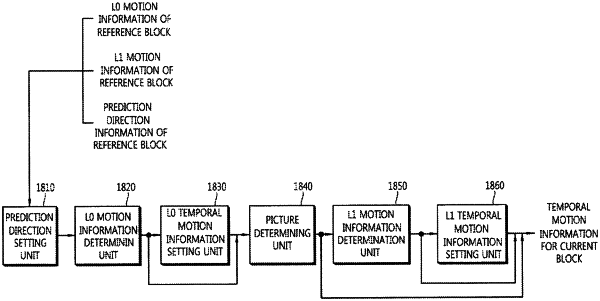| CPC H04N 19/159 (2014.11) [H04N 19/105 (2014.11); H04N 19/109 (2014.11); H04N 19/117 (2014.11); H04N 19/124 (2014.11); H04N 19/13 (2014.11); H04N 19/139 (2014.11); H04N 19/15 (2014.11); H04N 19/176 (2014.11); H04N 19/52 (2014.11); H04N 19/61 (2014.11)] | 11 Claims |

|
1. A method for decoding a video signal, the method comprising:
determining a prediction mode for a current block as an inter prediction mode;
determining a temporal motion information reference picture including temporal motion information of the current block from a reference picture list;
determining a temporal motion information reference block from the temporal motion information reference picture based on a spatial location of the current block;
determining the temporal motion information of the current block from the temporal motion information reference block;
determining a motion candidate list of the current block by using spatial motion information of the current block from neighboring blocks spatially adjacent to the current block and the temporal motion information of the current block from the neighboring blocks temporally adjacent to the current block;
determining motion information of the current block based on the motion candidate list and a motion candidate index;
determining a prediction method for the current block between uni-prediction or bi-prediction according to a size of the current block;
generating a prediction block of the current block by predicting the current block based on the prediction method and the motion information; and
reconstructing the current block based on the prediction block of the current block,
wherein the motion candidate index indicates a motion candidate included in the motion candidate list;
wherein the motion information of the current block includes prediction direction information and both of L0 motion information and L1 motion information,
wherein, when the prediction direction information of the current block indicates a bi-prediction method and a size of the current block is smaller than a pre-determined size, the prediction direction information indicating the bi-prediction method is changed to indicate a uni-prediction method and the prediction block of the current block is generated by performing motion compensation based on only the L0 motion information among the L0 motion information and the L1 motion information, and
wherein, when the prediction direction information indicates the bi-prediction method and the size of the current block is equal to or greater than the pre-determined size, the prediction direction information indicating the bi-prediction method is not changed to indicate the uni-prediction method and the prediction block of the current block is generated by performing the motion compensation based on both the L0 motion information and the L1 motion information.
|